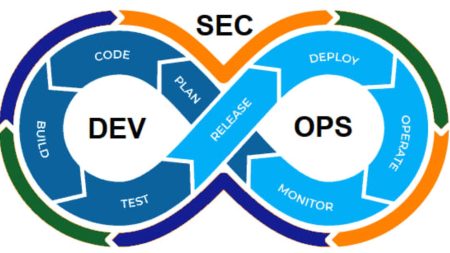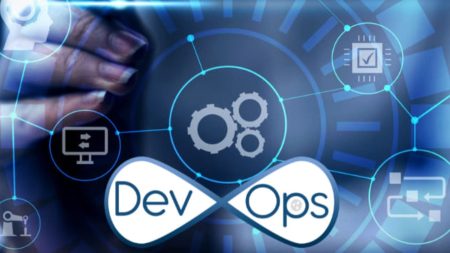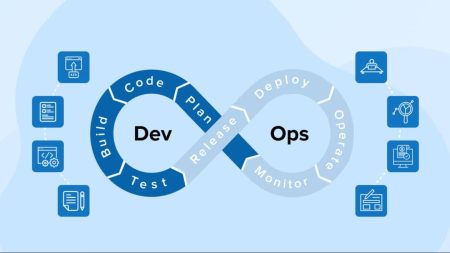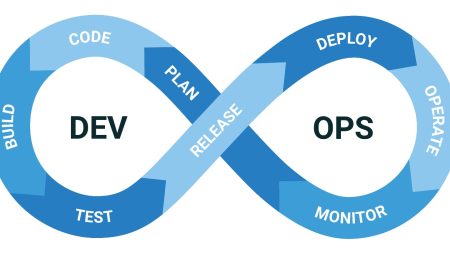Do you want to know what is DevOps is and how it can help your business succeed? If so, read on, and you will find out what it is, why it matters, and how it works. We will also provide some tips for starting DevOps in your organization. By the end of this article, you’ll better understand what is DevOps and how to get started implementing its principles in your business. So let’s dive in!
DevOps Model Defined
What is Dev Ops and how it works? It’s a mix of different ideas and tools that help teams make things faster and more reliable. It also allows people to communicate better to figure out problems quickly. DevOps helps businesses succeed by making sure that everything runs smoothly.
The basic principles of the DevOps can help your business run more efficiently and achieve better results. Here they are:
- Automation. Automating processes helps reduce repetitive tasks and teams can focus on more important things.
- Continuous Integration and Delivery. Code is tested regularly to ensure it meets quality standards. These principles also allow delivering new features quickly and safely.
- Monitoring. By monitoring systems, you can identify and fix problems quickly before they become serious issues.
- Security. DevOps helps ensure that software is secure by using automated tests and security checks.
How DevOps Works?
Combining software development and operations to accelerate the delivery of applications, services, and products is what is DevOps mean. It focuses on collaboration between developers and operations teams to improve communication, workflow efficiency, and product quality. By embracing the methodology and integrating processes from both teams into one unified system, DevOps helps organizations reduce time-to-market for their projects while ensuring they meet customer expectations regarding reliability and performance.
DevOps enables faster feedback loops through automation tools like continuous integration (CI) or continuous delivery (CD). These tools allow developers to quickly detect errors introduced during development by running automated tests on each code commit before deploying to production environments. This reduces the risk of introducing bugs into production systems because any issues can be identified early in the cycle when they are easier to fix, and allows for faster iterations.
Another essential part of DevOps is infrastructure as code (IaC). IaC allows organizations to define their server configuration using code instead of manually configuring them each time changes need to be made or new servers need to be set up. This makes it easier to scale up or down quickly as the number of users or load on the system changes. Finally, DevOps also encourages teams to use monitoring tools that help them understand how their systems are performing and identify areas of improvement.
Benefits of DevOps
1. Increased agility: DevOps facilitates faster release cycles and more frequent releases of software by automating processes and building in continuous feedback loops. Teams can quickly respond to customer needs or market changes and stay ahead of the competition.
2. Improved collaboration: DevOps encourages collaboration between developers, engineers, operations, and other members. This helps create a shared responsibility culture, leading to better communication and more efficient workflows.
3. Increased efficiency: Automation tools such as configuration management systems, testing frameworks, and continuous integration/delivery pipelines help DevOps teams deliver projects faster and with fewer errors.
Why DevOps Matters?
DevOps is crucial because it helps teams work together more quickly and efficiently. It also makes it easier for developers to complete their projects on time, with fewer mistakes and better customer satisfaction. DevOps helps businesses stay ahead of the competition by responding quickly to customer needs or market changes. Additionally, it allows teams to create better products faster by ensuring they get the feedback they need from their customers early in the process. Lastly, understanding what is Dev-Ops also helps organizations save time and money by automating processes and reducing errors.
DevOps Lifecycle
The DevOps lifecycle is an iterative process with multiple steps leading to the desired goals:
- Planning: Setting out the goals and objectives of the project, as well as the resources and timeline required to meet them.
- Development: Writing code to build the application or service.
- Testing: Running automated tests against the code to ensure it works properly before deployment.
- Deployment: Launching the application or service onto production systems.
- Monitoring: Continuously monitoring the application or service to ensure everything is running as expected. Any errors can be quickly identified and addressed in order to keep the system performing optimally.
DevOps Tools
DevOps tools help automate code compilation, deployment, testing, monitoring, and more tasks. DevOps, what is the main tool? One of the most popular DevOps tools is Ansible. It is an open-source configuration management tool designed to help teams automate their infrastructure setup. GitLab is another popular DevOps tool that helps teams manage projects from planning through deployment.
It provides features such as source code management, continuous integration/delivery pipelines, and issue-tracking tools. Finally, Jenkins is a free, open-source automation server that automates building, testing, and deploying applications. By embracing and understanding what is DevOps, organizations can improve their development processes and stay competitive in the ever-changing tech landscape.
Read also interesting article about benefits of DevOps.











